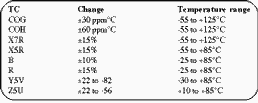
When demand for the most common types of capacitors is stretching the world's supply, the use of sensible alternatives can avoid difficulties and may even save money. Murata explains further.
By far the most popular capacitors used are the smaller multilayer ceramic chips (MLCCs). There are many variations available and they are increasingly replacing film and tantalum dielectrics. The majority is used in decoupling and bypass applications, although there is a significant use in temperature compensating and other functions.
Recently, the main changes in MLCCs have been in C/V per unit volume, so that the designer can now select a given C/V in a smaller package, for example, many of the values traditionally ordered in 1206 and 0805 sizes, are now in 0603 or even 0402. Volume users are moving to these sizes, so there will be more of them when delivery schedules get tight.
Difficulties can be minimised at the design stage by using the smaller sizes and more flexible definitions of MLCCs for general applications, with particular reference to the dielectric and voltage ratings (VR) chosen. For example, why specify only one VR? Most circuits today run at something under 10 V. It would be reasonable to specify 10, 16, 25 and 50 V where they are available in the size required?
MLCCs are often specified at unnecessarily high VRs. Unlike many other dielectrics the VR of an MLCC is the maximum voltage at which it can be run continuously within the operating temperature range. There is no need for a safety margin to avoid punching a hole in the dielectric at VR +5%, because the breakdown voltage of an MLCC is well above the operating voltage.
The same principle applies to a lesser degree to tolerance. High K dielectrics do have temperature, voltage and frequency characteristics and the selection of these materials indicates an application that will tolerate them. This being the case, relaxing or tightening the tolerance to allow use of an alternative may well be acceptable.
In decoupling and bypass applications the capacitance value is rarely critical. This suggests that similar but different dielectrics could safely be used. For example in a benign environment, why specify only an X7R dielectric (-55 to 125°C)? Why not consider Y5V and Z5U. They have a higher dissipation factor and change more with temperature, but why in signal lines where temperature is not changing very much and the value is not critical?
In applications calling for stability or temperature compensation, the situation is different but there are still opportunities to be more flexible.
The comments above about voltage rating still apply. For absolute stability COG (±030 ppm/°C) has to be the answer but perhaps COH (±060 ppm/°C) would suffice on some occasions?
With tolerance, in stable circuits there is a tendency to select the tightest available. This may be necessary, but in view of all the other variables, is it always the case?
Table 1 shows some of the dielectric alternatives you might consider at the design stage, or when a specified part is not readily available. Clearly, changing between X7R, X5R, B and R dielectrics will have negligible effect unless operating at the extremes of temperature, and there is little to choose between Y5V and Z5U.

These are just examples of what might be done at the design stage or when there is a problem. Your local Murata distributor will be able to assist - some of the alternatives for three popular devices are shown in Table 2. These are not the limits of the size/value ranges, they are just options for these values.


© Technews Publishing (Pty) Ltd | All Rights Reserved